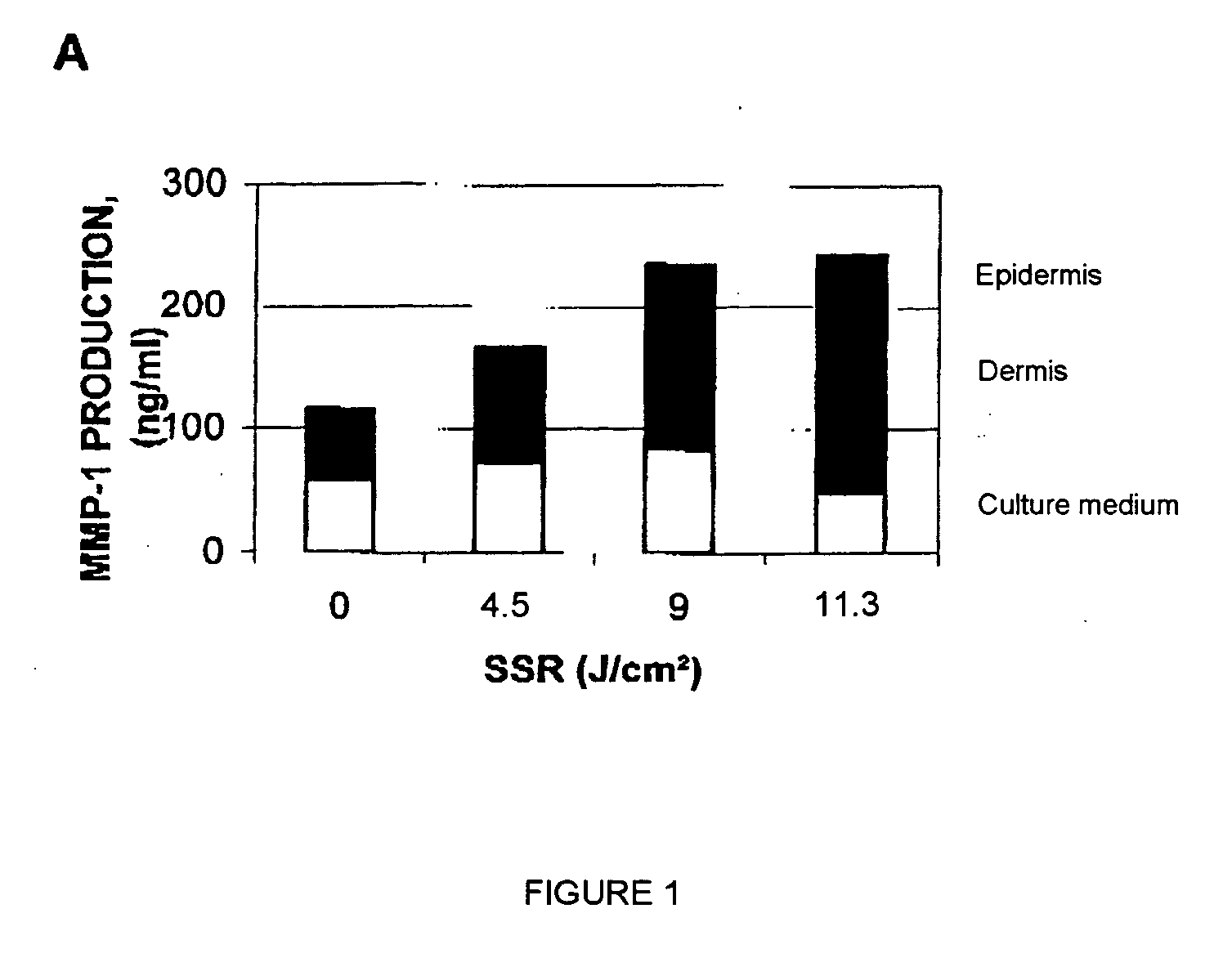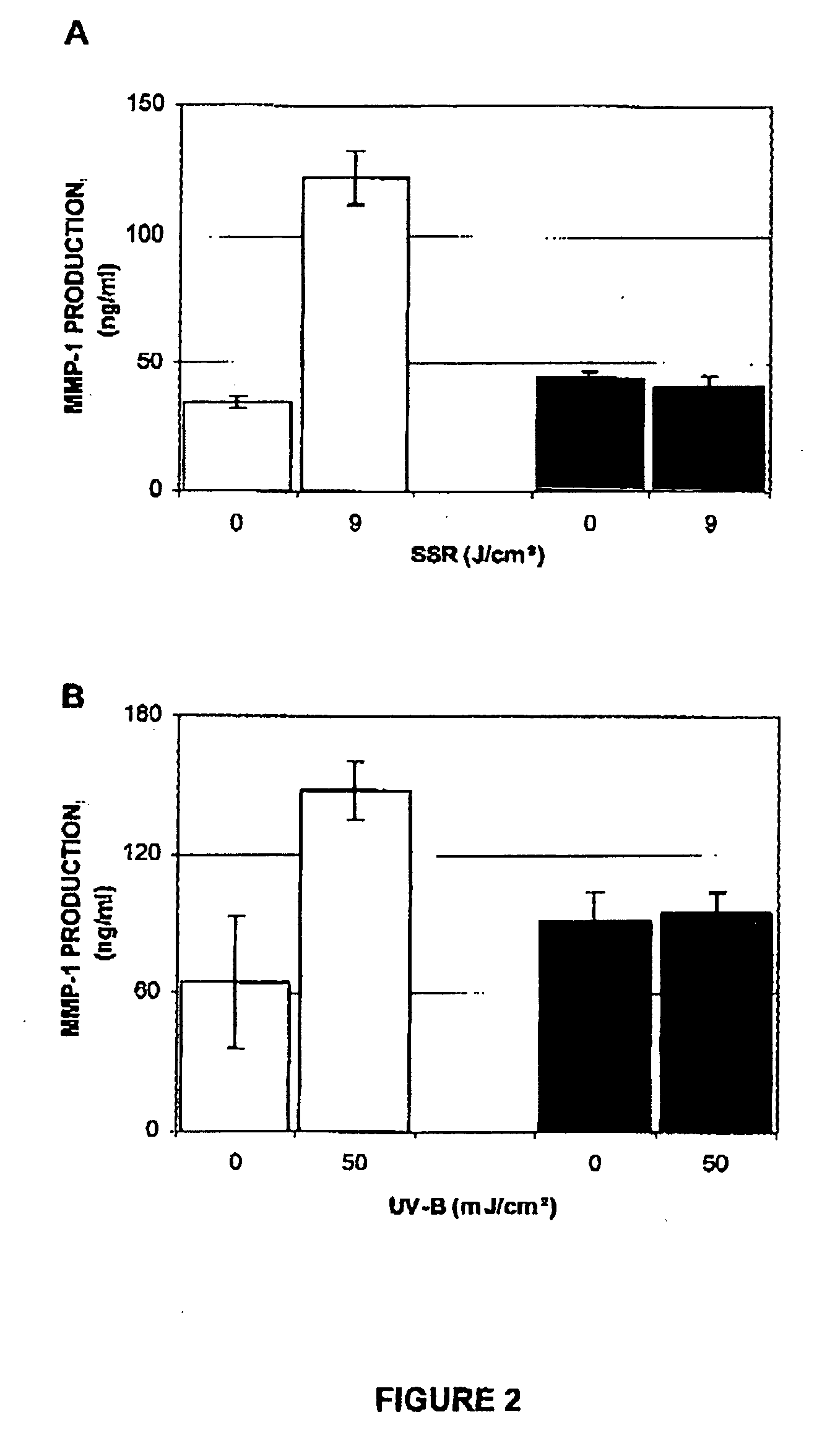Preventing and/or combating collagen fiber degradation induced under conditions of natural exposure to sunlight
a technology of natural exposure and collagen fiber, which is applied in the direction of cosmetics, instruments, biochemistry apparatus and processes, etc., can solve the problems of collagen degradation, thinning of the dermis, and no study performed to date has made it possible to reproduce the conditions clos
- Summary
- Abstract
- Description
- Claims
- Application Information
AI Technical Summary
Benefits of technology
Problems solved by technology
Method used
Image
Examples
example 1
Demonstration of the Role of Keratinocytic Cytosoluble Factors in the Production of MMP-1 by the Fibroblasts, Under Conditions of Simulated Natural Sunlight Exposure (SSR)
Materials and Methods:
Cell Cultures:
Human keratinocytes are isolated from normal human skin (breast surgery) and cultured on a nourishing layer of mitomycin-treated 3T3 mouse fibroblasts.
The human dermal fibroblasts are isolated from amplified mammary skin explants and cultured on Dulbecco's Modified Eagle's Medium (DMEM) containing 10% FCS, supplemented with glutamine (2 mM), sodium pyruvate (1 mM) and non-essential amino acids.
All the cell cultures are maintained at 37° C. under 5% CO2.
The reconstructed skins are composed of one equivalent of live dermis and of a differentiated epidermis, prepared as described in Asselineau et al. (1985), Exp. Cell. Res., 159, 536-539.
A model of reconstructed human epidermis, Episkin™ (Episkin SNC, France), was also used. Human mammary keratinocytes were inoculated ...
example 2
Selection of Inhibitors of the Production of Photoinduced Keratinocytic Cytosoluble Factors
Normal human keratinocytes cultured as a monolayer on plastic were subjected to a UV-B radiation (10 mJ / cm2). The experiment may also be performed in the presence of an SSR as defined in Example 1.
A Philips TL 20 W / 12 tube equipped with a Kodacel filter to remove the wavelengths below 290 nm is used as UV-B source.
Just before irradiation, the culture medium of the sub-confluent cells (80-90% of confluence) is replaced with a PBS phosphate buffer to avoid the generation of phototoxic products by the medium. Under these conditions, no loss of viability of the cells is observed at the UV doses used.
After irradiation, the cells were placed in contact with an MEM culture medium free of serum and of growth factor, which are known to interfere with the detection or production of MMP-1, containing or not containing sodium butyrate NaBu (3 mM).
The conditioned medium of the keratinocytes (irra...
example 3
Formulations
Composition 1: Facial care creamThe following oil-in-water emulsion is prepared in a conventionalmanner (% by weight):Sodium butyrate 1%Lycopene (in the form of Lycomato ® 0.001%containing 10% lycopene in a tomatooleoresin, sold by Lycored ®Glyceryl stearate 2%Polysorbate 60 (Tween 60 ® sold by ICI) 1%Stearic acid 1.4%Triethanolamine 0.7%Carbomer 0.4%Liquid fraction of shea butter 12%Perhydrosqualene 12%AntioxidantqsFragranceqsPreservativeqsWaterqs 100%Composition 2: Facial care gelSodium butyrate 10−5%Hydroxypropylcellulose (Klucel H ® sold 1.00%by Hercules)Antioxidant 0.05%Isopropanol 40.00%Preservative 0.30%Waterqs100.00%Composition 3: Lotion for preventing hair lossMonoacetone glucose-3-butyrate 1%Lycopene (in the form of Lycomato ®0.0001%containing 10% lycopene in a tomatooleoresin, sold by Lycored ®)Propylene glycol 30%Ethanol 55%Waterqs 100%Composition 4: Plant or animal gelatin gel capsulemg / gel capsuleSodium butyrate10Starch198Magnesium ste...
PUM
| Property | Measurement | Unit |
|---|---|---|
| Fraction | aaaaa | aaaaa |
| Fraction | aaaaa | aaaaa |
| Percent by mass | aaaaa | aaaaa |
Abstract
Description
Claims
Application Information
 Login to View More
Login to View More - R&D
- Intellectual Property
- Life Sciences
- Materials
- Tech Scout
- Unparalleled Data Quality
- Higher Quality Content
- 60% Fewer Hallucinations
Browse by: Latest US Patents, China's latest patents, Technical Efficacy Thesaurus, Application Domain, Technology Topic, Popular Technical Reports.
© 2025 PatSnap. All rights reserved.Legal|Privacy policy|Modern Slavery Act Transparency Statement|Sitemap|About US| Contact US: help@patsnap.com



